In studying the Short-run equilibrium in a monopoly, its purpose is to maximize profits. Before we discuss the short-run equilibrium in monopoly, let’s learn about the definition and characteristics of a monopoly.
A monopoly is another extreme type of market that exists in the microeconomic theory. As perfect competition itself, a pure monopoly may not exist in real world situation. However, the study of this market model provides us with guidelines and approacheses to study the monopolistic markets.
Characteristics of the monopoly market
- There is only one seller in the market, but there is a large number of buyers.
- Supply a unique product and no close substitutes for the product. Thus cross-elasticity of demand between the product of the monopolist and every other product is zero or close to zero.
- There are strong entry barriers to the industry.
- Perfect information
The market models which fulfill all these conditions are called a pure monopoly. However, since it is tough to see the markets that satisfy all these conditions, pure monopoly is also a hypothetical market model like perfect competition.
Definition: A monopoly is a market structure in which there is a single seller, selling a unique product. In a monopolistic market, the seller does not face any competition. He is the only seller of the commodity with no close substitute.
Facts which causes a monopoly market
- Knowledge of raw material ownership or production technology is essential.
- A product or manufacturing process requires a patent or copyright.
- Government license required.
- The imposition of foreign trade barriers to prevent the influences of foreign competitors.
- When the size of the market does not support more than one supplier.
- The limited-pricing policy is required to avoid new entrants.
These factors serve as barriers to the entry of new firms.
Demand and Revenue Curves of the Monopolist
As there is only a single seller in the market, the monopolist demand curve is the industry’s demand curve. The monopolist can be known as a price maker. So he can decide either quantity supplied or the price of the commodity.
However, these two decisions are interdependent. When he decides, the market will determine the quantity equilibrium price. When he determines the price, the equilibrium quantity will be determined by the market.
This shows that the monopolist cannot make both the quantity and price he wants to sell independently. And also he can sell more and more of the product to the declining price. That implies the demand curve is downward sloping. So the monopolist does not have a full market as to the competitive firm.
The Equation for the Demand Curve and Revenue Curves
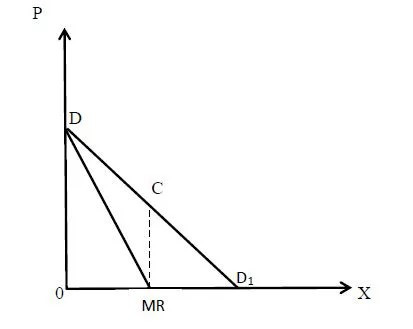
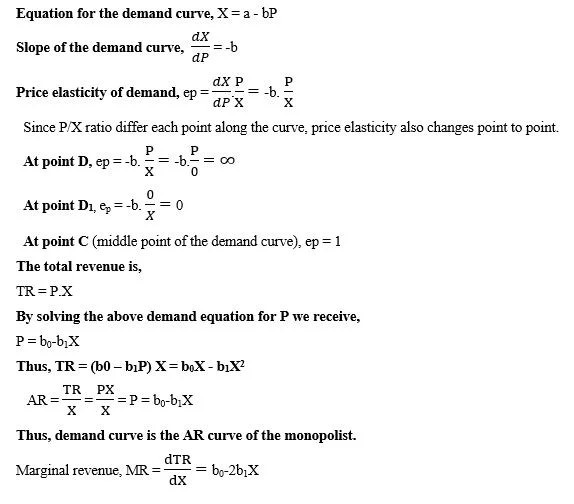
This proves that the demand and MR curves have the same intercept, but the slope of the MR curve is twice the slope of the demand curve.
Cost Curves of the Monopolist
The cost curves of the monopolist are the same as in pure competition. Accordingly, AVC, ATC, and MC are U-shaped, while AFC is a rectangular hyperbola.
Short run Equilibrium in Monopoly
The goal of the monopolist is to maximize profit. Thus, the monopolist’s equilibrium conditions are the same as in the conditions of a competitive firm. Hence, the equilibrium conditions are:
First-order condition MR = MC
Second-order condition, the slope of MR curve < slope of MC curve
The following figure shows the short-run equilibrium of the monopolist which fulfills the above condition.
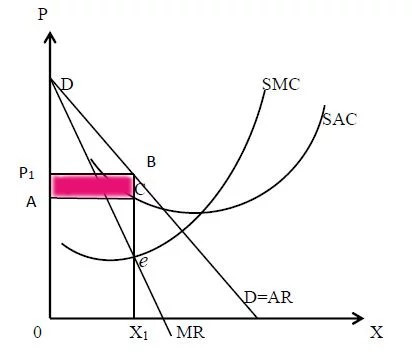
The equilibrium point is e, at which the MC curve cuts the MR curve from below. At this point, both conditions are fulfilled. So the equilibrium price is P1 and the quantity is X1.
TR = 0P1BX1 and TC = 0ACX1.
Thus, monopolist earns excess/supernormal profit equal to the area of AP1BC. This implies that a monopolist can make an excess profit in the short run.
It can be observed that there is a significant difference between monopoly equilibrium and competitive equilibrium. Although, the equilibrium price under perfect competition equal to MC, the monopoly price is higher than MC. This is because the monopolist faces a downward sloping AR curve, and his MR curve lies below the AR curve. Hence, at the equilibrium MR=MC condition satisfied at a point below the price P (=AR). In the above graph, the equilibrium output is 0 -X1. MR and MC equal to X1 – e. It is less than the Price (=AR) which is equal to X1–B (0–P1)
Monopoly Firm Can Earn Losses in the Short-run
Generally thought that monopolists could earn supernormal profit in the short-run. However, there is no guarantee of excess profit always. If the demand is not adequate to set the price product’s price for his benefit, he will earn losses. For example, in the time of depression, demand is very low. Hence, when the price is less than AC, the firm will earn losses. However, if the price is higher than AVC, he will continue in the short-run. If the losses continue in the long-run he will leave the industry.
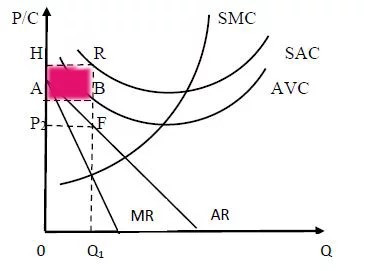
The equilibrium price is P1 and the quantity is Q1. The firm earns losses equal to the area of P1GHS. Although P<SAC is higher than AVC, the firm will continue in the short-run.
If the P<AVC as shown below, the firm will leave in the industry.
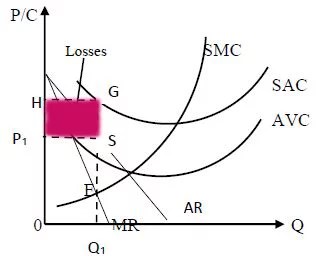
The demand curve (=AR) lies even below the AVC. The equilibrium price is P2 and the quantity is Q2. The firm losses equal to the fixed cost ABRH plus variable cost equal to the area of P2ABF. Since the losses are greater than the fixed cost it is not rational to further produce. Hence the firm will leave the industry.
Relationship between AR, MR and Price Elasticity
Price elasticity at any point of a demand function can be written as

Real-World Cases of Monopoly
- United Kingdom
- British Telecom
- Buildingand maintaining UK telecommunication network
- Royal Mail
- Postal distribution network
- Camelot
- Operate the UK national network of lottery
- National Rail
- Owns, manages and leases the UK railway network
- National Grid
- Owns and operates the National Grid high-voltage electricity transmission network in England and Wales
- London Underground
- British Telecom
Questions
1. What is short run equilibrium under monopoly?
2. What are the characteristics of the monopoly market?
3. How monopolist maximize profits in the short run?
4. Can a monopolist incur losses in the short run?
Conclusion
All right then. In this article, we discussed short run equilibrium in monopoly. Did you find this blog post helpful? If so, who could share it with? I’m trying to improve my website’s usability. Is there anything on my site you’re having trouble finding? Let me know by leaving comment.
Related Topics
Monopoly – Price discrimination: Types, Degrees, Graphs, Examples
Monopolistic Competition and Economic Efficiency
Perfect Competition: Definition, Graphs, short run, long run
Monopolistic Competition Assumptions [Updated]


